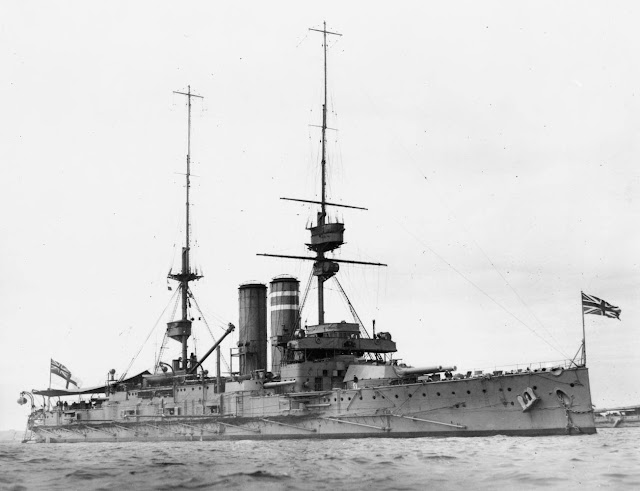Ship and Naval History from the late 19th century to the late 20th century. Please feel free to leave comments any feedback is always appreciated.
Monday, 16 September 2019
HMS King Edward VII
HMS King Edward VII and her seven sisters comprise the second largest class of battleships ever built and where the final design submitted by Sir William White, the man who designed the late Victorian Royal Navy. These ships were the first major departure from the original design White had produced back in the early 1890s with the Majestic Class, the main feature being the addition of four 9.2" guns in single turrets in the corners of the superstructure, and the 6" battery being all on a single deck, instead of being on two levels in casemate's as had been the case with the Majestic, Canopus, London, Formidable, Queen and Duncan Classes. Backed up with the standard Main Armament battery of four 12" guns these ships could pour out a terrific volume of fire, much greater than any earlier British battleship, and comparable to contemporary foreign design's which were starting to mount an intermediate battery of 7.5", 8" or 10" guns. These ships were the first British Battleships to feature a mixed Oil and Coal-fired boilers, with oil fuel being kept in tanks held in the ships double bottom. All ships proved to be reliable steamers in service, and all bettered their expected top speed of 18kts, top speed in service proved to be around 19.5kts. The addition of oil Sprayers to the ship's boilers meant that they could easily outstrip the rest of the fleet if need be. Very useful when chasing an enemy fleet. In service, the class were given the nickname of the "wobbly eight" predominantly because they had a high metacentric height meaning the class were rather more prone to roll. R.A. Burt states that a time of 14 seconds was all it took for a double roll to happen. When compared to the earlier Bulwark class there were considered wet ships, having a slightly lower freeboard (eight inches), however, they were also considered very good sea-boats, and found to be very quick to answer the helm. Formed into their own complete squadron in peacetime, during the Great War this class formed the 3rd Battle Squadron, and spent the first two and a half years of the war operating with the Grand Fleet Dreadnoughts. Over the course of the Great War two of the class were lost. HMS King Edward VII herself was lost in January 1916 to a mine strike, taking 9 hours to sink. HMS Britannia was torpedoed and sunk just off Cape Trafalgar on 9th November 1918, she took two and a half hours to sink and became the last British warship sunk in WW1. The long sinking times of both ships is a testament to the Damage Control operated by both crews in trying circumstances (Britannia especially as she suffered a secondary explosion in one of the 9.2" magazines after the torpedo strike), but also the toughness of the ship's design.
Subscribe to:
Post Comments (Atom)
USS Eldridge (DE-173)
The USS Eldridge was a destroyer escort built for the United States Navy during World War II. It was part of the Cannon class and was ...

-
HMIS Bengal was a 1040 ton Bathurst-class corvette built to an Australian design for the Royal Indian Navy and only completed in August 1...
-
During the ongoing struggle to reinforce and preserve Suzuki's 35th Army on Leyte, the First Striking Force had spent all it's time ...


No comments:
Post a Comment